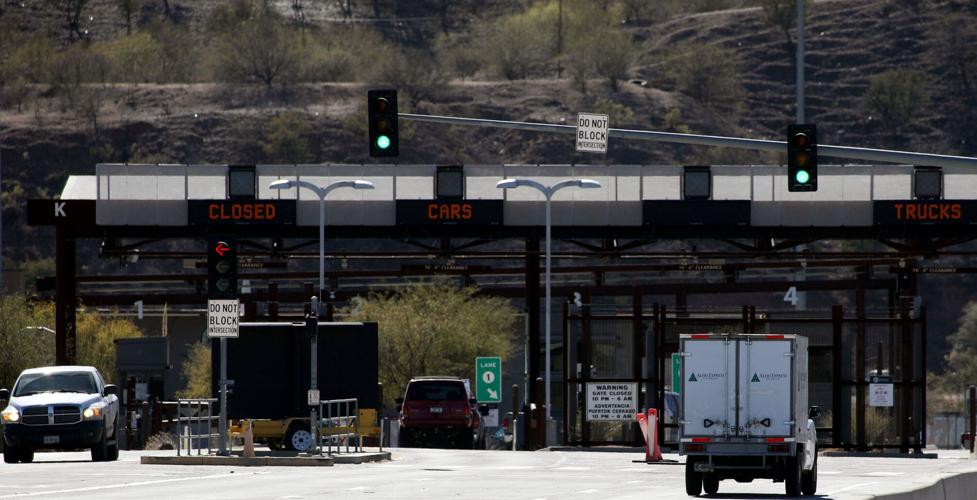Arizona stakeholders are calling for Congress to fully fund the installation of non-intrusive inspection technology at U.S. ports of entry, following a national report that a lack of Congressional funding has left critical scanning machines sitting unused in warehouses.
This week U.S. Rep. Raúl M. Grijalva sent a letter to House and Senate Appropriations Committee leaders, urging them to fully fund installation of fentanyl scanners and other non-intrusive technology, which allow the agency to quickly x-ray vehicles without impeding the flow of commerce and traffic across the border.
Fentanyl scanners, which are in place at ports of entry in Nogales, are “critical to stopping dangerous fentanyl from entering our country through our ports of entry,” wrote Grijalva, a Tucson Democrat. “However, recent reports indicating that fentanyl scanners are sitting unused in warehouses because Congress has not appropriated funding to install them is incredibly troublesome and must be immediately addressed.”

Rep. Raúl Grijalva
U.S. Customs and Border Protection has not yet responded to the Arizona Daily Star’s inquiry about whether there is any unused inspection equipment waiting for installation at Arizona ports of entry.
Grijalva is the latest Arizona official to issue such a call, in the wake of NBC News reporting that some ports of entry have uninstalled equipment due to the lack of funds.
“We do have technology that’s in the warehouse that has been tested,” CBP Commissioner Troy Miller told NBC News, during a tour of the Mariposa port in Nogales earlier this month. “But we need approximately $300 million (to) actually put the technology in the ground. It’s extremely frustrating.”
In a Monday visit to Nogales with Arizona Rep. Ruben Gallego, state Attorney General Kris Mayes called out “extremists” in Congress for blocking the failed bipartisan border-security package in early February, which would have funded tools to stop the flow of fentanyl into the U.S.
Under pressure from former President Donald Trump and top House Republicans, GOP senators voted to kill the bipartisan legislation, co-authored by Sen. Krysten Sinema, I-Arizona.
Half of the fentanyl seized in the U.S. in recent years was interdicted in Arizona, Mayes wrote in a March 7 letter to Arizona’s Congressional delegation urging funding to install scanning equipment.
“Because of the actions of the Mexican drug cartels, Arizona now serves as the fentanyl funnel for the rest of the nation,” the Democratic attorney general said. “This devastating public health crisis has wrecked communities, harmed families, and pushed drug overdose deaths to astronomical heights. It is ridiculous that technology that would help prevent the flow of this drug into our country sits unused because of Congressional inaction.”
About 90% of drugs seized nationally by CBP are discovered at the ports of entry, rather than by border agents between ports of entry, according to CBP.
So far, in fiscal year 2024, which began in October, CBP has seized more than 7,000 pounds of fentanyl; 6,000 pounds of that was seized by officers at the ports of entry.
“CBP has stopped more fentanyl in the last two years than in the previous five years combined, and we continue to optimize our intelligence and field operations to stop these deadly substances from reaching American communities,” according to a February CBP statement.
Yet CBP is only able to scan a fraction of personal and commercial vehicles that enter the U.S. at ports.
Miller told NBC News that less than 5% of personal vehicles entering the U.S. are scanned, and 20% of commercial vehicles. He’d like to raise those figures to 40% and 70%, respectively.

Jaime Chamberlain
Nogales’ Mariposa and DeConcini ports of entry interdict more fentanyl than any other port in the nation, said Jaime Chamberlain, board chairman for the Greater Nogales and Santa Cruz County Port Authority. Providing adequate resources, and the latest technology, at ports of entry is critical, he said.
Surges in migrant arrivals between ports of entry have led to the U.S. Department of Homeland Security reassigning port officers to assist Border Patrol agents with processing migrants, he said.
This week, Gallego, a Democrat running for the U.S. Senate, and other Arizona legislators have also been pressing legislators to approve additional Shelter and Services Program funding, which would prevent the unsheltered street releases of legally processed migrants, expected to begin in Tucson on April 1.
Shifting resources from the ports into the field is short-sighted and detrimental to national security, Chamberlain said.
“How can we continue with this uncertainty?” he said. “We’re always waiting for the ax to fall, or in this case, a decision to come from DHS to pull men and women in blue from Customs away, to give them to Border Patrol. And for what? For processing (migrants), not for patrol.”
While Chamberlain said he’s not aware of non-intrusive inspection equipment that’s sitting uninstalled in Arizona ports of entry, this type of equipment — working in concert with highly-trained human and canine inspectors — is critical for the country’s fight against fentanyl smuggling, he said.
“This is one of the reasons why we’re saying that DHS’s decision to pull people away from the ports of entry just doesn’t make sense at this critical time, when we’re being flooded with (fentanyl),” he said.
Get your morning recap of today's local news and read the full stories here: tucne.ws/morning







